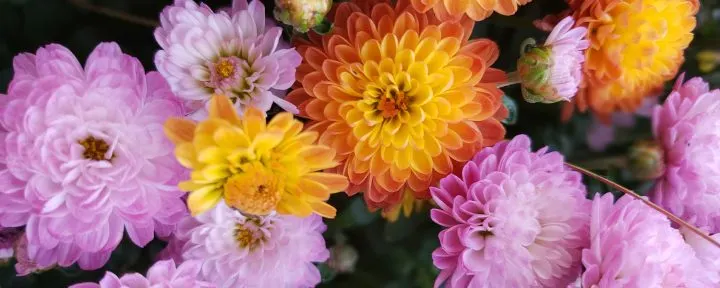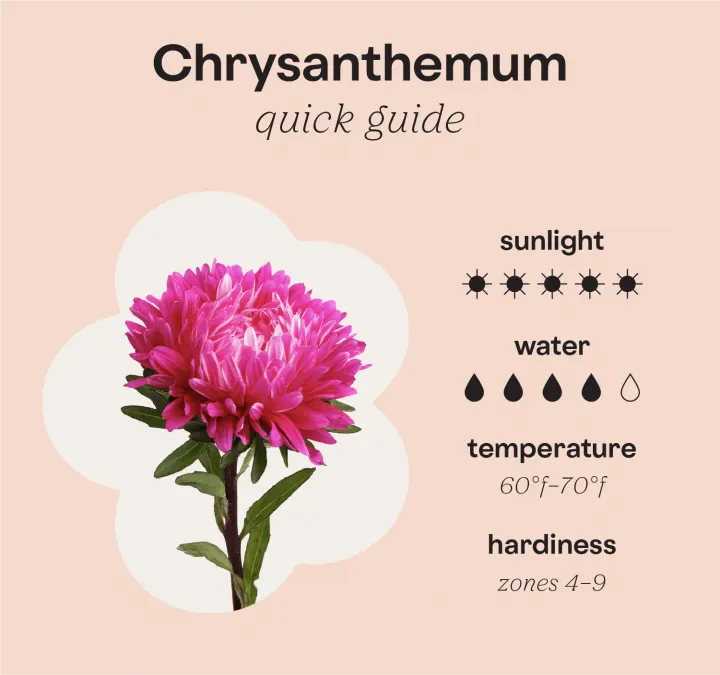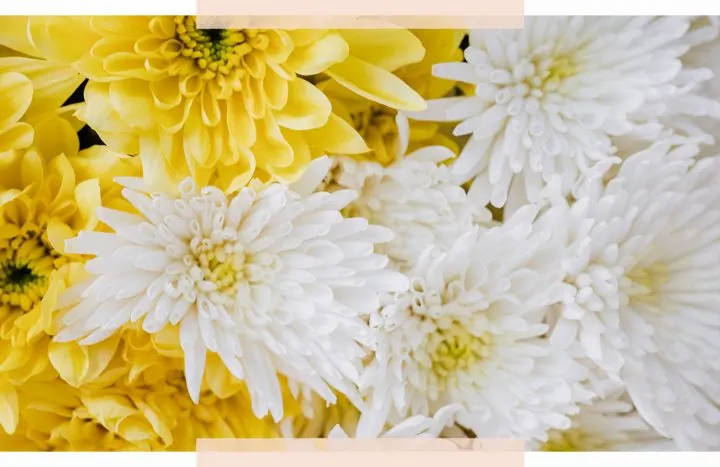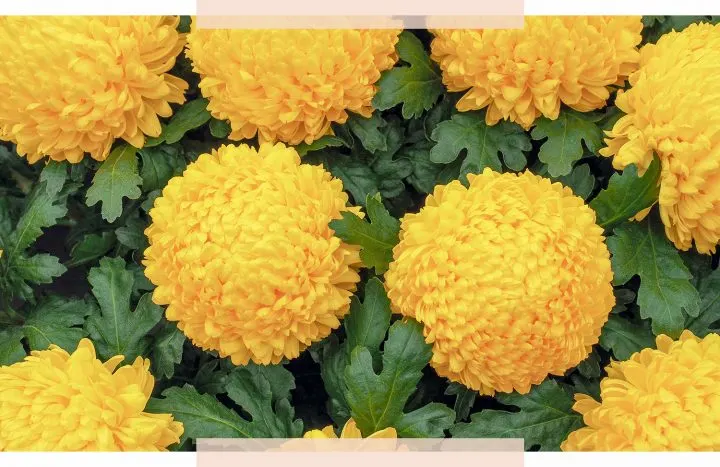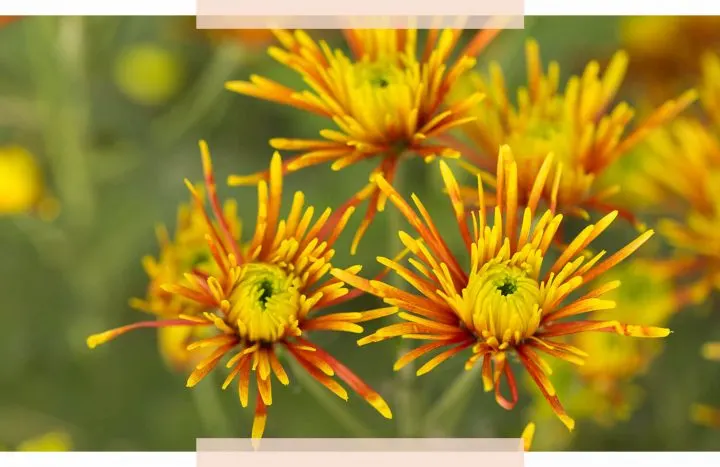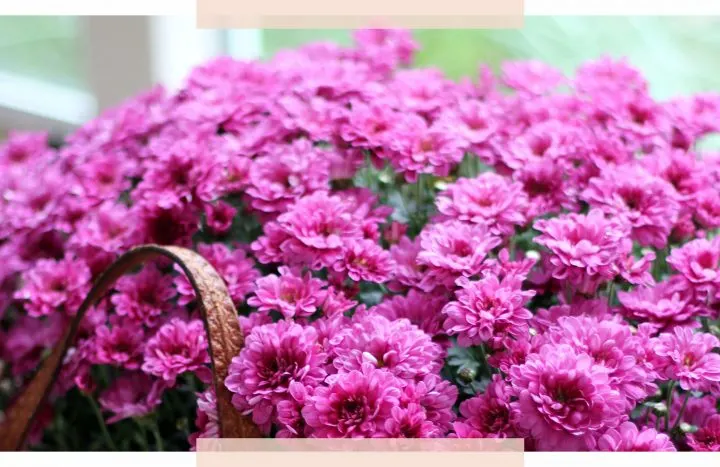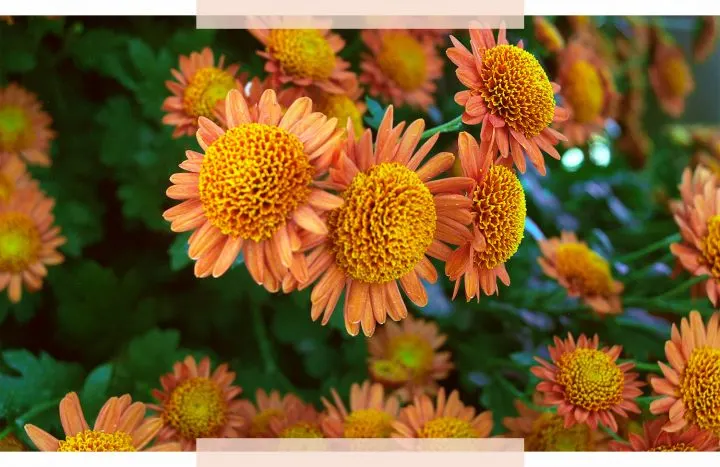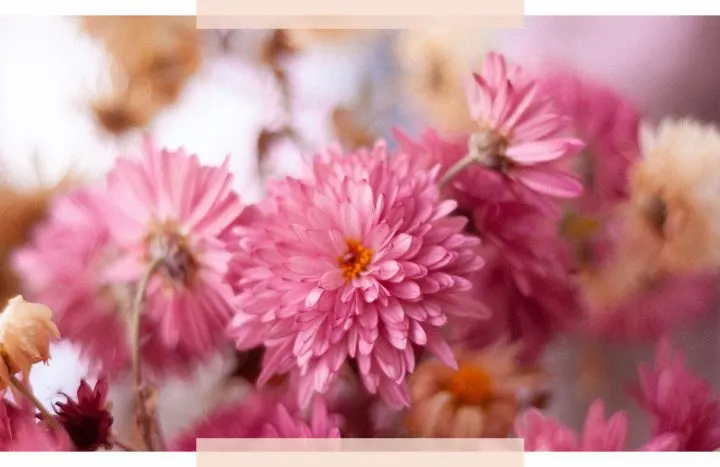November 17, 2021
Chrysanthemum Care Guide: Tips and Advice
The chrysanthemum flower is a beautiful fall staple known for its seasonality and variety of colors. These can make a stunning addition to any garden or can be used as a festive fall decoration, both inside and out.
Chrysanthemums are one of the easier flowers to care for, mainly needing ample light and water. There are still a few things to keep in mind though, especially if you want to ensure that your garden mums come back year after year. We’ve created the ultimate chrysanthemum care guide to help you enjoy these beautiful flowers regardless of if they are in a container or in your garden.
Chrysanthemum Overview
The chrysanthemum, originally cultivated in China, belongs to the Asteraceae family. This is the largest family of flowering plants and includes over 23,000 species. Over the years, the mum traveled to Japan, where it was adopted as the emperor’s crest and seal due to its beauty.
The symbolism of chrysanthemums can change depending on color, with some of the most popular colors being:
White: Symbolizes honesty and loyalty
Red: Denotes love and passion
Purple: Conveys “get well” wishes
With the chrysanthemum being November’s official birth flower, it’s no wonder that it’s considered the “Queen of Fall Flowers.” While mums can be grown in the garden as early as spring, they can also be used as a decorative element during the autumn season.
Are Chrysanthemums and Mums the Same?
In short, yes! Chrysanthemums are commonly referred to as mums and can be interchanged as you like. Just know that whenever you hear the term “mum” or “chrysanthemum,” it’s all the same beautiful fall flower.
How To Care for Chrysanthemums
Although chrysanthemums are rather easy to care for, it’s important to know how to set your plants up for success. Mums require lots of sun, plenty of water and moderate temperatures.
As a reminder to pet parents: Chrysanthemums are toxic to pets, so keep them out of reach. Continue reading for more specific information on chrysanthemum care.
Planting
If you’re planting mums from seeds, it’s best to start them indoors. Give them about six to eight weeks indoors before the last frost in the spring, then they can be transplanted outdoors.
When selecting a spot, remember that mums can grow to a height of one to three feet. It’s best to keep a distance of 18 to 36 inches between plants, as they can be as wide as they are tall. It’s important to dig the hole for the plants around the same depth as the pot, or even a little deeper, to allow proper rooting. This will help keep the roots from getting too wet, which can cause root rot.
After planting mums, it’s important to add a layer of mulch. This will help retain moisture (which is important to the mum) and will help keep your mums insulated for the colder months. Consider using materials like shredded bark, grass clippings or shredded leaves.
Sunlight
Chrysanthemums love the sun and do best when there’s plenty of it. Mums require only six hours of sunlight a day but if they are provided more, they will have better growth and hardiness. If mums don’t receive enough sunlight, they will tend to be weaker with fewer blooms. Keep in mind that if the sun is hot, it’ll be best to provide some shade to prevent scorching your flowers.
Temperature
Mums thrive best in moderate climates. Specifically, the best temperature for mums to grow is around 70 degrees Fahrenheit during the day, and no colder than 60 degrees Fahrenheit at night. If nighttime temperatures are consistently high, your mum might bloom later than expected.
Humidity
While chrysanthemums do like humidity, too much can cause them to become diseased. If your mums are inside, strive for a relative humidity level of 40 to 50 percent. For outdoor chrysanthemum flower care, a higher humidity level is preferred, although it’s important to ensure the plants have space around them.
Water
In the same way that mums require a lot of sun, they also need a healthy dose of water to thrive. Regardless of the type of mum, remember to water at the soil level and not the blooms. Watering at the blooms can cause certain diseases to your mums and will require pruning to help save.
If you’re planting mums in the garden, they need to have moist soil until established (about one inch of water a week). Once rooted, make sure to water two to three times a week to keep the soil moist, as they don’t thrive as well when the soil dries out.
For potted mums, watering should occur at least every other day. Similar to garden mums, they require about one inch of water per week. It’s important to water thoroughly enough that water drains from the drainage hole in the pot, keeping the soil moist but not wet. Even with this much moisture, if the plant happens to wilt, it’s best to place it in a bucket with water so the roots can absorb the water directly.
Soil
The best soil for chrysanthemum flowers to thrive in is well-draining soil with consistent moisture. If the soil is too wet, mums will rot, and if the soil is too dry, the roots will have a hard time getting established. A good rule of thumb is to plant mums in the same type of soil that you would plant other perennial plants. A soil pH of 6.0 to 8.0 is preferred.
Toxicity
Chrysanthemums are extremely toxic to pets such as cats, dogs and horses. Because of this, it’s important to keep any mums in a place where they cannot be reached by pets or other animals that might visit your yard, or stick to pet-safe plants for your household instead.
Repotting & Propagation
Repotting: Repotting chrysanthemums is important to help them grow. When purchasing a potted mum, the roots can often be tangled or crammed, making it hard for water to be absorbed.
For this reason, it’s important to choose a pot that is bigger than the original container to allow the roots to spread and grow. Potting soil is crucial to promote the healthy growth of your mum. For a reference point, fill the new pot with the mum and then add soil until you have about an inch of free space below the lip of the new container.
Propagation: Mums can be easily propagated in a few ways, with the easiest being division.
With division, you can take mums that you’ve grown in your garden for at least two years and divide them to bring new life and new blooms. Keep in mind that springtime is the best time to do this, and remember to ensure that there is at least 18 inches of space between them.
Pests and Problems
Pests: Aphids, mites and thrips, while hard to spot, can cause the biggest damage. While you might not notice the insects right away, signs of infestation include stem and leaf damage in addition to the formation of webs on the plants. To remove these pests, you can use blasts of water on the plants or an insecticidal soap spray.
Problems: While the chrysanthemum might be easy to grow, it doesn’t come without its share of potential problems. Plant problems such as leaf spots, rust, root rot and aster yellows are things that need to be monitored.
Types of Chrysanthemums
While there are thousands of different varieties of chrysanthemum flowers, there are a few popular and recognizable ones. Most notably, the petal shapes are all quite different, making the mum a truly unique flower.
1. Single Bloom
SIngle bloom mums are a very common variety. This variety boasts a flat center with many petals on the outside and often looks similar to daisies. In fact, many of the single bloom mums have white petals and yellow centers. These can grow between two to three feet tall and, as the name suggests, only produce one bloom.
2. Pompon
Perhaps one of the most recognizable types of mums, the pompon mums have a spherical shape with short, curled petals. These are often referred to as a button mum and can be found in a wide variety of colors, including green, red, yellow and orange.
3. Spider
The spider mum is a truly unique variety with its name stemming from the looks of its petals. These mums can grow to six inches wide and have petals that are tubular in shape. The long, thin petals tend to grow in different directions and make this variety one that’s considered not especially hardy.
4. Quilled Bloom
This type of mum is usually seen as a florist mum, used for seasonal decoration purposes. These petals also have a tubular shape and stick straight out as if trying to showcase the colorful center.
5. Cushion
These are different from most garden mums, as they are low-growing shrubs. These are often mid-sized and are known for being bushy in nature. Expect these to produce many blooms to give a pop of color and style to your garden.
6. Anemone
The anemone mum is rather special; they have short, tubular petals and a large central disk that appears to be cushioned by the petals. The anemone flower heads are typically larger than other mum varieties.
7. Decorative
You might be surprised to learn that there is a specific type of chrysanthemum that is considered decorative, as opposed to being labeled as any other variety. These are usually short-stemmed flowers with extravagant blooms showcasing bright colors.
Chrysanthemum FAQs
If you find yourself still having questions about chrysanthemums, we’ve got a list of common questions below to help guide you through caring for your mums:
What Is the Difference Between a Garden Mum and a Florist Mum?
Mums can be broken down into two different categories: garden and florist.
Florist mums are usually the ones that are sold indoors during the fall season. While technically a perennial, these are bred as annuals. This is because they don’t have a rooting system that makes them capable of returning year after year, so planting these in a garden is not optimal. Typically, they are used for fall and Thanksgiving decorations.
Garden mums, on the other hand, are hardy perennial plants that should come back year after year. These are typically sold outdoors and do produce a rooting system, making them a great addition to the garden.
Do Chrysanthemums Come Back Every Year?
This depends on what season you plant them in. Planting your mums in the spring is the best time if you want them to return, as this will give them the longest time to become rooted. Planting in the fall time is oftentimes too late to ensure they will rebloom.
It’s important to note that the above is only true for garden mums; florist mums are considered to be more like annuals, and therefore will not return due to their inability to root.
Are Chrysanthemums Edible?
Chrysanthemums are edible and are most widely used in tea. A best practice for this is to ensure that they have not been sprayed with any chemicals; due to this, plucking mums from your own garden might be best.
To make chrysanthemum tea, dry out the petals first and make a teabag to hold the petals. These flowers produce a mild flavor that can be described as similar to chamomile. The more flowers you add to your tea, the stronger the flavor will be.
Be aware that if you have allergies to ragweed or daisies, there’s a good chance you will suffer a reaction to chrysanthemums. If taking medication, it would be a good idea to consult a doctor before drinking mum tea, as it might interact with certain medications. That being said, studies have shown that certain chemicals in chrysanthemum flowers can help reduce inflammation when taken long-term.
Chrysanthemum Bouquet Care Tips
Creating a mum bouquet is a great way to trim any blooms to prepare for the winter and makes a great addition to indoor fall decor. Consider adding mums to other fall flowers for a unique fall gift.
Trim the Stems
When cutting mums out of your garden to place in a vase, early morning or late evening hours are best to cut. Make sure that you use sharp shears and place them in a bucket of warm water as you cut so they don’t dry out as you prepare your bouquet.
When bringing home mums from the store, always ensure that you are trimming the ends before placing them in water. It’s important to note that the best way to trim already-cut mums is under running water, as the stems can close up in a matter of seconds, leaving air bubbles within the stem.
Arrange Chrysanthemums in a Vase
Once your stems are cut, you can start to assemble your bouquet. Initial vase water should be around 100 to 110 degrees Fahrenheit to allow maximum hydration. It’s also important here to remove any lower foliage, as this could stimulate the growth of bacteria. As with all cut flowers, consider adding flower food to the vase to help keep your flowers nourished.
Replace Water
When the vase water becomes cloudy or discolored, it’s time to replace it. At this stage you can allow the vase water to come to room temperature; while this is happening, you can keep the mums in a bucket with water to prevent the ends from sealing.
Add Accents (Optional)
As this is a fall flower, you can choose to make a festive table bouquet with orange and red mums with accents of pumpkins, fall foliage or twisted branches.
For a classic arrangement, pair green mums with roses and tulips to give your bouquet a whimsical look.
Or, to keep things simple, pair different-colored mums together. With so many color options to choose from, the options are (almost) endless.
Mums can bring about feelings of seasonal joy, whether in a garden, planter or vase. Try your own hand at chrysanthemum care by using the tips in this guide, or feel free to check out our selection of mums for an easy-to-give gift.

